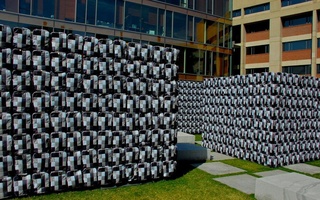Seen from the window of a descending airplane, a city sprawls out in astonishing intricacy, a maze-like network of stacked structures and winding, convoluted pathways. Unfamiliar in unexpected ways, it reveals the obsessive and overwrought patterns of human activity in all their inscrutable complexity. Too bad that, in the last weightless moments before touchdown, the city metamorphoses into something more pedestrian--disappearing, finally, into the invisibility with which we cloak the everyday. Up close, we see nothing at all.
In "Landmark Pictures," currently at the Busch-Reisinger, artists Ed Ruscha and Andreas Gursky maintain that precious, otherworldly estrangement in chronicling the very ordinary. Ruscha, in fact, literally takes us into the plane with him in his series "34 Parking Lots in Los Angeles." Shot aerially, their meticulously drawn lines, directional arrows and predictably spaced gas stains are suddenly mesmerizing--and humorous. One stand-out is the photograph of the Dodger Stadium parking lots: emanating radially from the stadium like the leaves of an artichoke, they are at once industrial and organic. Ruscha's painted evocations of Los Angeles' grid-like topography (straight lines, written names) likewise succeed in turning our personal (and local and national) geographies topsy-turvy.
Gursky, similarly, is committed to cataloguing the structural artifice left behind by humanity. The pairing with Ruscha is a bit unusual, but it works. Despite differences in age, geographical origin and medium--Ruscha is an LA-based artist who got his start as a humble sign-painter in the '60s, while Gursky is a much younger, German-born photographer--the two engage with at times startlingly similar themes. In his images of endless hotel interiors, meticulously arranged 99-cent stores and cold Prada showrooms, Gursky, like Ruscha, presents everyday structures as pure expressions both of the human and something more than human--as if to point out that in such places humanity will be memorialized, but also outlasted, superceded.
Deceptively simple, Gursky's images fail to come apart with attempts at interpretation. A rendering of two divergent ramps off the Autobahn, for example, might be painfully boring if the ramps weren't, on second glance, so unsettling (where do they lead? why are they empty?). By pausing to reconsider the banality of these and other objects, edifices and locations, he challenges and transcends the literal gaze. Thus, a gridded ceiling, shot at such an angle as to show only the aureoles of light created by the implied light bulbs, becomes an immense tapestry of light and shadow--something more like a photographic Victor Vasarely image than a ceiling. Most remarkable of all is Gursky's Untitled, 1993, in which the vaguely modulated picture surface resolves into an expanse of well-tread, nubby carpet. Austere and precisely executed like all his other photographs, Untitled, 1993 transforms the humdrum by deeming it worthy of attention. This is astounding realism, both representational and abstract, documentary and mythical.
All in all, "Landmark Pictures" is an admirable look at two fascinating urban imagists--and the mundane places they render true landmarks of the imagination.
Read more in Arts
Q&A: Carson DalyRecommended Articles
-
CalendarVISUALS Calendar of Events CALENDAR: ON COLOR, projects by students and faculty, curated by Judy Batalion '00 and Emily von
-
Ed RuschaThursday, Nov. 10. 6 p.m. Carpenter Center. Free. “Clarence Jones, 1904-1987,” reads a gravestone-like inscription superimposed upon a rugged mountain
-
Davis Deals With Controversy Over Art in ‘America’s House’Watched more closely than any other in a generation, life for the First Family cannot be without its challenges, chief ...
-
‘Untitled’ Seeks MysteryEnigma is the intrigue of “The Untitled Project,” a self-conscious play that breaks the barrier between audience and actor, and focuses on the very process of making theater. The hour-long show will run in multiple locations—ranging from the Signet Society to the Holyoke Center Gallery—from Friday to Sunday, and aims to separate itself from the typical trajectory of many of today’s plays by remaining somewhat mysterious.
-
 Ai Weiwei’s 5,335 Backpacks Hold Political, Artistic Charge
Ai Weiwei’s 5,335 Backpacks Hold Political, Artistic Charge -
Notes on Ai WeiweiIt was when he moved back to China to be with his ailing father that Ai grew interested in the social landscape of his country, and began to ask how one could utilize modern design techniques to highlight political issues.













